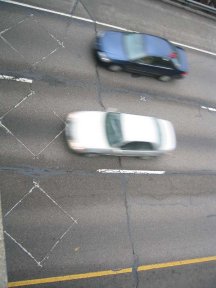Traffic managers in urban settings monitor networks of roadway sensors as one way to detect congestion. The faster those networks recognize problems, the quicker authorities can alert motorists and emergency teams to possible trouble.


Now, Benjamin Coifman of Ohio State University in Columbus has devised a way to sense jams more quickly by tracking the motion of trucks or other large vehicles within the overall traffic flow. Amid the torrent of vehicles on highways, he says, those big vehicles stand out much the way breadcrumbs do if dropped into a stream of water.
The new sensing strategy, described in the March Transportation Research
Part A, can identify incipient traffic jams in about a quarter the time of conventional automatic detection methods, Coifman claims. What’s more, the data needed to apply the technique can be obtained using the sensors already embedded in many highways.
It’s “a significant breakthrough in the way freeways can be operated,” comments Joseph A. Palen of California’s transportation agency, Caltrans. Palen worked with Coifman to try out the new jam-sensing scheme on a freeway near San Francisco.
The method relies on signals from so-called loop detectors–typically square coils of wire about 2 meters on a side that lie beneath the highway surface and emit electrical signals as vehicles pass over them.
In use since the 1960s, loop detectors have been installed every kilometer or so along major routes in many urban areas. They enable traffic engineers to tally the vehicles that pass a certain spot, for example, or to determine the average speed of those vehicles.
Coifman wondered what loop detectors might reveal about individual cars and trucks. In the past few years, he has measured vehicle length with loop detectors arranged in closely spaced pairs. He found that dual-loop detectors could precisely measure the lengths of trucks and other long vehicles but not of cars. To use these detectors as jam sensors, Coifman created a computer program that scores a “match” each time a particular truck, distinguished by its length, passes successive sets of detectors within an interval of time that would be possible only if traffic were flowing well.
During smooth traffic, the number of matches stays within a certain range, Coifman notes. However, the number of matches suddenly plummets when a slow-down begins.
Calling the new jam-monitoring method “valuable and promising,” Carlos F. Daganzo of the University of California, Berkeley points out that conventional loop-detector networks don’t respond to congestion until vehicles have slowed down all the way back to the first detector station upstream of the delay.
That can take minutes, Coifman notes. In contrast, the new technique monitors traffic flow between detector stations, so it can recognize the first signs of a jam within tens of seconds.
****************
If you have a comment on this article that you would like considered for publication in Science News, please send it to editors@sciencenews.org.
To subscribe to Science News (print), go to https://www.kable.com/pub/scnw/
subServices.asp.
To sign up for the free weekly e-LETTER from Science News, go to http://www.sciencenews.org/subscribe_form.asp.





